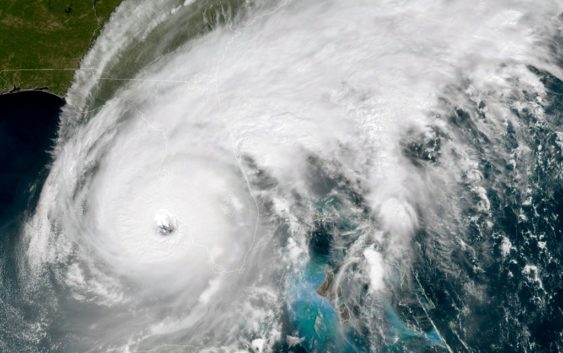Hurricane Ian makes landfall in southwest Florida

The storm has forced millions to evacuate.
ST. PETERSBURG, Fla. — Hurricane Ian made landfall Wednesday in southwest Florida as one of the most powerful storms ever recorded in the U.S., swamping city streets with water and smashing trees along the coast.
The hurricane’s center struck Wednesday afternoon near Cayo Costa, a protected barrier island just west of heavily populated Fort Myers. The massive storm was expected to trigger flooding across a wide area of Florida as it crawls northeastward across the peninsula.
Mark Pritchett stepped outside his home in Venice around the time the hurricane came ashore about 35 miles to the south. He called it “terrifying.”
“I literally couldn’t stand against the wind,” Pritchett wrote in a text message shortly after landfall. “Rain shooting like needles. My street is a river. Limbs and trees down. And the worst is yet to come.”
The Category 4 storm slammed the coast with 150 mph winds and pushed a wall of storm surge accumulated during its slow march over the Gulf of Mexico.
About 2.5 million people were ordered to evacuate southwest Florida before the storm hit. Though expected to weaken as it marched inland at about 9 mph (14 kph), Ian’s hurricane force winds were likely to be felt well into central Florida.
Deaths from the hurricane had already been reported in Cuba, where two people were killed as Ian tore into the island as a major hurricane Tuesday, bringing down the country’s electrical grid.
“This is going to be a nasty nasty day, two days,” Florida Gov. Ron DeSantis said, stressing that people in Ian’s path along the coast should rush to the safest possible shelter and stay there.
Off the coast on Sanibel Island, just south of where Ian made landfall, traffic cameras hours earlier showed swirling water that flooded streets and was halfway up mailbox posts. Seawater rushed out of Tampa Bay as the storm approached, leaving parts of the muddy bottom exposed, and waves crashed over the end of a wooden pier at Naples.
Ian had strengthened rapidly overnight, prompting Fort Myers handyman Tom Hawver to abandon his plan to weather the hurricane at home and head across the state to Fort Lauderdale.
“We were going to stay and then just decided when we got up, and they said 155 mph winds,” Hawver said. “We don’t have a generator. I just don’t see the advantage of sitting there in the dark, in a hot house, watching water come in your house.”
The governor said the state has 30,000 linemen, urban search and rescue teams, and 7,000 National Guard troops from Florida and elsewhere ready to help once the weather clears.
Florida residents rushed ahead of the impact to board up heir homes, stash precious belongings on upper floors and join long lines of cars leaving the shore.
Some decided to try and ride out the storm. Jared Lewis, a Tampa delivery driver, said his home has withstood hurricanes in the past, though not as powerful as Ian.
“It is kind of scary, makes you a bit anxious,” Lewis said. “After the last year of not having any, now you go to a Category 4 or 5. We are more used to the 2s and 3s.”
Ian made landfall more than 100 miles (160 kilometers) south of Tampa and St. Petersburg, sparing the densely populated Tampa Bay area from its first direct hit by a major hurricane since 1921. Officials warned residents that Tampa could still experience powerful winds and up to 20 inches (50 centimeters) of rain.
“Please, please, please be aware that we are not out of danger yet,” Tampa Mayor Jane Castor said in a video on Twitter. “Flooding is still going to occur.”
Ash Dugney warily watched ocean water being sucked out below a Tampa Bay pier Wednesday morning. He said he didn’t trust Tampa’s storm drainage system to keep his corner tuxedo rental business safe from flooding that he said has happened even during mild storms.
“I don’t care about the wind and the rain and the stuff like that, I just care about the flooding,” Dugney said, adding that he moved essentials out of the shop and moved other items up to above waist-high level.
Flash floods were possible across all of Florida. Hazards include the polluted leftovers of Florida’s phosphate fertilizer mining industry, more than 1 billion tons of slightly radioactive waste contained in enormous ponds that could overflow in heavy rains.
Isolated tornadoes spun off the storm well ahead of landfall. One tornado damaged small planes and a hangar at the North Perry Airport, west of Hollywood along the Atlantic coast.
More than 1 million homes and businesses were without electricity, and Florida Power and Light warned those in Ian’s path to brace for days without power.
The federal government sent 300 ambulances with medical teams and was ready to truck in 3.7 million meals and 3.5 million liters of water once the storm passes.
“We’ll be there to help you clean up and rebuild, to help Florida get moving again,” President Joe Biden said Wednesday. “And we’ll be there every step of the way. That’s my absolute commitment to the people of the state of Florida.”
Parts of Georgia and South Carolina also could see flooding rains and some coastal surge into Saturday. Georgia Gov. Brian Kemp preemptively declared an emergency, ordering 500 National Guard troops onto standby.
Associated Press contributors include Christina Mesquita in Havana, Cuba; Cody Jackson and Adriana Gomez Licon in Tampa, Florida; Freida Frisaro in Miami; Anthony Izaguirre in Tallahassee, Florida; Mike Schneider in Orlando, Florida; Seth Borenstein and Aamer Madhani in Washington; Bobby Caina Calvan in New York; Andrew Welsh-Huggins in Columbus, Ohio; and Jay Reeves in Birmingham, Alabama.